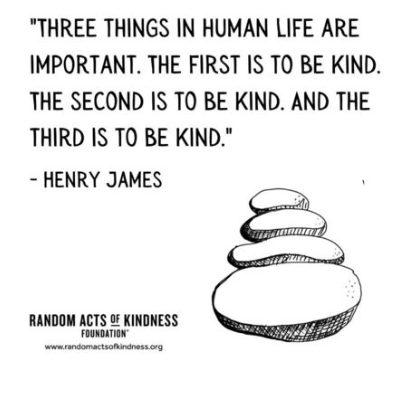Overview
This lesson invites students to consider that kindness is an everyday, intentional choice to focus on seeing and uplifting others. It is putting the needs of someone else before self. How can I go about my day intentionally watching for others in need of kindness? The goal is not to spend money but to spread kindness. Consider the simple random acts of kindness that can change your mood (or perhaps someone else) instantaneously: someone holding a door open, being celebrated for a job well done, taking time to speak with a child who’s having a hard day, hearing “I’m glad to see you today!”, exchanging an encouraging smile with someone who is discouraged, hugging your parent, saying and meaning, “I love you” etc.
The Random Acts of Kindness website offers many valuable lesson plans, activities, and resources for teachers, including inspirational quotes that could be used for quick writes, persuasive debate topics, or for a monthly focus in your classroom: https://www.randomactsofkindness.org/for-educators. If you’ve ever seen or read Wonder, do you recall Auggie’s teacher posting precepts each month – Video clip: https://tinyurl.com/y3xkwtbk. In this lesson, students will individually reflect on kindness, meet in small groups or with a partner to brainstorm ways of showing kindness and engage in a shared reading of an informational text from Newsela about Stan, the Man who owns a bookmobile where kids earn books (rather than buy books) through acts of kindness.
NB Curricular Connections
Curriculum Connection:
Personal Wellness 3-5
-
- Strand: Relationships – Big Idea: Healthy Relationships – Skill Descriptor:
- Grade 3: Identify strategies to build and enhance friendships.
- Grade 4: Identify the importance of communication to build and maintain healthy relationships.
- Grade 5: Describe empathic responses and their impact on relationships.
- Strand: Mental Fitness – Big Idea: Positive Mental Health – Skill Descriptor:
- Grade 3: Explore the importance of talking about emotions and emotional responses.
- Grade 4: Describe the seven primary emotions and their expression.
- Grade 5: Identify ways to manage stress and regulate emotions.
- Strand: Relationships – Big Idea: Healthy Relationships – Skill Descriptor:
Personal Wellness 6-8
-
- Strand: Relationships – Big Idea: Healthy Relationships – Skill Descriptor:
- Grade 6: Discuss the characteristics of healthy relationships.
- Grade 7: Describe strategies to build and maintain healthy relationships.
- Grade 8: Apply strategies to build and maintain healthy relationships.
- Strand: Relationships – Big Idea: Healthy Relationships – Skill Descriptor:
Personal Wellness 6-8
-
- Strand: Mental Fitness –Big Idea:Positive Mental Health – Skill Descriptor:
- Grade 6: Describe strategies to maintain positive mental health.
- Grade 7: Analyze the impact of mental health on well-being.
- Gade 8: Evaluate behaviours/environments that help foster positive mental health and build resilience.
- Strand: Mental Fitness –Big Idea:Positive Mental Health – Skill Descriptor:
What you’ll need
- Copies of the article: At Stan the Man’s Bookmobile, Kids Buy Books with Acts of Kindness. The article provided also includes multiple-choice comprehension questions and answers – make sure to avoid including these pages if you’re printing the text for students!)
Are you trying to reduce your photocopies? Project text for whole class reading or students can share the text with a partner. The text provided is intended for grade 5 readers.
(Membership with Newsela is free! You can adjust the reading level of the same text for all readers in your class. There are additional features like comprehension quizzes and extension activities which we’ve included as well; they also have article collections on various themes in numerous subject areas).
- Copies of the written response sheet for each student: Random Acts of Kindness & Stan the Man’s Bookmobile – Response Sheet
Instructions
- Think about it/Write about it: [5-10 minutes]
Read the quote by Henry James at least twice out loud to students. Students are encouraged to work independently or with a partner to reflect on their understanding of the quote provided and what kindness means to them. Guiding questions are provided to assist in their quick-write – this is practice writing intended for students to get their ideas on the page. Please encourage them to follow an idea wherever it leads; don’t focus on spelling but on generating ideas.
The class can always return to this section to refine/revise their understanding during the lesson.
If your time permits, allow for a whole-class discussion about students’ understanding of the quote. Reinforce there are many ways of responding to the prompt. Which comments are similar? Build on one another’s answers: Daneen, your response connected with mine…Or you made me think about…Or I hadn’t thought about…
- Brainstorm It: [10 minutes]
Students will brainstorm a list of ways to show kindness to others through words, drawing images, symbols, etc. to fill the thinking bubble.
- Think, Pair, Share It: [5-10 minutes]
Students will partner with a classmate and then move into a small group to share and compare answers. This is not intended as a competition but as an opportunity for each student to add more ideas to their list after meeting with others. By meeting with others, we refine/clarify our ideas/understanding and have the potential to build personal connections with others by sharing our ideas.
Have students reflect on their best examples of kindness (top 3) with a star or heart for future discussions.
- Predict it & Question It: [5-7 minutes] Students are invited to generate 2 relevant predictions and 2 relevant questions using only the title of the shared text.
Predictions: “Making predictions about the text helps the reader to become mentally prepared to understand the ideas in a text. Predicting provides a purpose for readers.” (Cross-Curricular Reading Tools, 2006, p.23).
- I predict that…because…
- I wonder if…
- From this text, I predict I will learn…
- [Build on their prior knowledge] I predict this text will be about…because I already know about…
Questions: This is an opportunity to discuss the difference between THICK or THIN questions. THIN questions are typically answered with yes/no – they’re not ideal for generating discussion. THICK questions have multiple answers or include words like: explain, why, in your opinion, provide examples, etc. What is the author trying to say when…?
- Before reading, decide: how will students read this text? (teacher read-aloud; independent reading; shared reading with a partner?) How will they summarize each section? (Assign sections to various students to read aloud to the whole class or in small groups; independently; partners?)
- Read It & Summarize It: [30-40 minutes]
After reading the article, consider inviting students to collaborate on summarizing a section of the text in small groups. What are the essential ideas to remember from each section? List in bulleted points. If they were explaining the article to someone who had not read it, which key details would they need to include?
- [Optional Extension Activity] Create It:
Invite students to use their ideas from the Brainstorm It section to create a one-month calendar of their own, filled with easy, no-cost ways of showing kindness to others. For an example, visit https://www.randomactsofkindness.org/for-educators.
- Or work together collaboratively to generate a summer kindness challenge 2-month calendar.
- Or, for a larger challenge, invite classes in your school to generate a school-wide Random Acts of Kindness calendar as a fundraiser!
- Or consider how you could incorporate a kindness challenge of the day as a part of your morning announcements.
Career Connections
- Can you recall an experience where someone’s kindness made you less afraid or more courageous? (a Dentist who had a trick to calm your fears before dental work; a teacher who helped reduce evaluation anxiety; a coach who knew how to help you focus before a tough game, a baker who always had a treat for you, a grandparent who always had time to listen, etc.)
- Identify groups of people who could use more kindness? Identify a list of jobs that focus on helping those who may be overlooked or marginalized (not treated fairly) by society?
- What might contribute to people losing their attitude of kindness throughout the day? How can you ensure you are always able to be kind to others?
- If you enjoy being connected to people and working with others, what kinds of jobs allow you to work with others every day?
- What helping jobs exist beyond nursing and teaching? (In health care, in the community, in science/research, innovation/technology, etc.). It’s almost impossible to find any job or career where you work in isolation – most jobs involve working with and collaborating with others.
Attachment
Random Acts of Kindness Article
Random Acts of Kindness Lesson
Reflection Activity
Please see the attached PDF for several choices on how you and your learners can reflect upon today’s activity.




